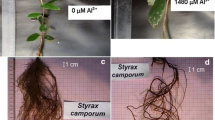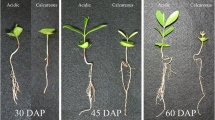Abstract
Key message
Styrax camporum, an Al-accumulating species from the Cerrado, seems to rely on the exudation of citric and oxalic acids to avoid excessive Al.
Abstract
Organic acid (OA) exudation by the roots of plants to chelate aluminum (Al) and forming non-toxic complexes is a known mechanism of Al exclusion in some plants, including some Al-accumulating species. The Cerrado vegetation in South America is composed of Al non-accumulating species and some Al-accumulating species from few families, all growing healthy on acidic soils with high Al saturation but never tested for OA exudation. We elected Styrax camporum (Styracaceae), a Cerrado woody species that accumulates in their leaves approximately 1500 mg Al kg−1 dry mass, to examine whether plantlets of this species exude OAs in response to changes in Al concentrations in a nutrient solution, for 30 days. Citric, malic and oxalic acids exuded by the roots of this species were cumulatively measured in nutrient solutions containing 0, 740 and 1480 μM Al. Also, we measured the Al concentration of whole plantlets at 0 and 30 days. Malic acid was not exuded by the plantlets, but it was detected inside root tips of plantlets exposed to Al. Plantlets exposed to 740 μM Al released more oxalic and citric acid in the nutrient solution than those exposed to 0 and 1480 μM Al after 30 days. On the other hand, between 0 and 30 days, plantlets exposed to 740 μM Al increased the Al concentration (in whole plantlet) by three times while those exposed to 1480 μM Al, by seven times. This higher OA exudation associated with lower Al uptake at 740 μM Al suggests an Al exclusion mechanism that is impaired at higher Al concentrations. This is the first report showing that an Al-accumulating species from the Cerrado exudes OAs in response to the Al concentration in the root environment.




Similar content being viewed by others
References
Andrade LRM, Barros LMG, Echevarria GF, do Amaral LIV, Cotta MG, Rossatto DR, Haridasan M, Franco AC (2011) Al-Hyperaccumulator Vochysiaceae from the Brazilian Cerrado store aluminum in their chloroplasts without apparent damage. Environ Exp Bot 70:37–42
Banhos OFAA, Carvalho BMO, Da Veiga EB, Bressan ACG, Tanaka FAO, Habermann G (2016a) Aluminum-induced decrease in CO2 assimilation in ‘Rangpur’ lime is associated with low stomatal conductance rather than low photochemical performances. Sci Hortic 205:133–140
Banhos OFAA, Souza MC, Habermann G (2016b) High aluminum availability may affect Styrax camporum, an Al non-accumulating species from the Brazilian savanna. Theor Exp Plant Physiol 28:321–332
Bremner JM, Keeney DR (1966) Determination and isotope-ratio analysis of different forms of nitrogen in soils: 3. Exchangeable ammonium, nitrate, and nitrite by extraction-distillation methods. Soil Sci Soc Am Proc 30:577–582
Bressan ACG, Coan AI, Habermann G (2016) X-ray spectra in SEM and staining with chrome azurol S show Al deposits in leaf tissues of Al-accumulating and non-accumulating plants from the cerrado. Plant Soil 404:293–306
Brunner I, Sperisen C (2013) Aluminum exclusion and aluminum tolerance in woody plants. Front Plant Sci 4:1–12
Carr HP, Lombi E, Küpper H, McGrath SP, Wong MH (2003) Accumulation and distribution of aluminium and other elements in tea (Camellia sinensis) leaves. Agronomie 23:705–710
Chenery EM (1948) Aluminum in plants and its relation to plant pigments. Ann Bot 12:121–136
Clark RB (1975) Characterization of phosphatase of intact maize roots. J Agric Food Chem 23:458–460
Fischer E, Speier A (1895) Darstellung der Ester. Chem Ber 28:3252–3258
Haridasan M (1982) Aluminium accumulation by some cerrado native species of central Brazil. Plant Soil 65:265–273
Haridasan M (2008) Nutritional adaptations of native plants of the cerrado. Braz J Plant Physiol 20:183–195
Haridasan M, Paviani TI, Schiavini I (1986) Localization of aluminum in the leaves of some Al-accumulating species. Plant Soil 94:435–437
Horst WJ, Wang Y, Eticha D (2010) The role of the root apoplast in aluminium-induced inhibition of root elongation and in aluminium resistance of plants: a review. Ann Bot 106:185–197
Jansen S, Broadley MR, Robbrecht E, Smets E (2002) Aluminum hyperaccumulation in angiosperms: a review of its phylogenetic significance. Bot Rev 68:235–269
Kissmann C, Habermann G (2013) Seed germination performances of Styrax species help understand their distribution in Cerrado areas in Brazil. Bragantia 72:199–207
Kochian LV, Hoekenga OA, Piñeros MA (2004) How do crop plants tolerate acid soils? Mechanisms of aluminum tolerance and phosphorous efficiency. Annu Rev Plant Biol 55:459–493
Kopittke PM, Blamey FPC, Menzies NW (2008) Toxicities of Al Cu, and Lainclude ruptures to rhizodermal and root cortical cells of cowpea. Plant Soil 303:217–227
Kopittke PM, Blamey FPC, Asher CJ, Menzies NW (2010) Trace metal phytotoxicity in solution culture: a review. J Exp Bot 61:945–954
Kopittke PM, Moore KL, Lombi E, Gianoncelli A, Ferguson BJ, Blamey FPC, Menzies NW, Nicholson TM, McKenna BA, Wang P, Gresshoff PM, Kourousias G, Webb RI, Green K, Tollenaere A (2015) Identification of the primary lesion of toxic aluminum in plant roots. Plant Physiol 167:1402–1411
Ma Z, Miyasaka SC (1998) Oxalate exudation by taro in response to Al. Plant Physiol 118:861–865
Ma JF, Hiradate S, Nomoto K, Iwashita T, Matsumoto H (1997) Internal detoxification mechanism of Al in hydrangea: identification of Al form in the leaves. Plant Physiol 113:1033–1039
Ma JF, Hiradate S, Matsumoto H (1998) High aluminum resistance in buckwheat: II. Oxalic acid detoxifies aluminum internally. Plant Physiol 117:753–759
Ma JF, Ryan PR, Delhaize E (2001) Aluminium tolerance in plants and the complexing role of organic acids. Trends Plant Sci 6(6):273–278
Malta PG, Arcanjo-Silva S, Ribeiro C, Campos NV, Alves-Azevedo A (2016) Rudgea viburnoides (Rubiaceae) overcomes the low soil fertility of the Brazilian Cerrado and hyperaccumulates aluminum in cell walls and chloroplast. Plant Soil 408:369–384
Morita A, Yanagisawa O, Takatsu S, Maeda S, Hiradate S (2008) Mechanism for the detoxification of aluminum in roots of tea plant (Camellia sinensis (L.) Kuntze). Phytochemistry 69:147–153
Morita A, Yanagisawa O, Maeda S, Takatsu S, Ikka T (2011) Tea plant (Camellia sinensis L.) roots secrete oxalic acid and caffeine into medium containing aluminum. Soil Sci Plant Nutr 57:796–802
Nguyen NT, Nakabayashi K, Thompson J, Fujita K (2003) Role of exudation of organic acids and phosphate in aluminum tolerance of four tropical woody species. Tree Physiol 23:1041–1050
Nogueira MA, Bressan ACG, Pinheiro MHO, Habermann G (2019) Aluminum-accumulating Vochysiaceae species growing on a calcareous soil in Brazil. Plant Soil 437:313–326
Ryan PR, Delhaize E, Randall PJ (1995) Characterization of Al-stimulated malate efflux from root apices of Al-tolerant genotype of wheat. Planta 196:103–110
Sarruge JR, Haag HP (1974) Análises Químicas Em Plantas. ESALQ (USP), Piracicaba. In: Portuguese
Scalon MC, Haridasan M, Franco AC (2013) A comparative study of aluminium and nutrient concentrations in mistletoes on aluminium-accumulating and non-accumulating hosts. Plant Biol 15:851–857
Silva CMS, Cavalheiro MF, Bressan ACGB, Carvalho BMO, Banhos OFAA, Purgatto E, Harakava R, Tanaka FAO, Habermann G (2019) Aluminum-induced high IAA concentration may explain the Al susceptibility in Citrus limonia. Plant Growth Regul 87:123–137
Souza MC, Bueno PCP, Morellato LPC, Habermann G (2015a) Ecological strategies of Al-accumulating and non-accumulating functional groups from the cerrado sensu stricto. Ann Braz Acad Sci 87:813–823
Souza MC, Franco A, Haridasan M, Rossatto DR, de Araújo JF, Morellato LPC, Habermann G (2015b) The length of the dry season may be associated with leaf scleromorphism in cerrado plants. Ann Braz Acad Sci 87:1691–1699
Tahara K, Norisada M, Yamanoshita T, Kojima K (2008) Role of binding ligands in aluminum resistance of Eucalyptus camaldulensis and Melaleuca cajuputi. Plant Soil 302:175–187
von Uexküll HR, Mutert E (1995) Global extent, development and economic impact of acid soils. In: Date RA et al (eds) Plant soil interactions at low pH. Kluwer Academic Publishers, Dordrecht, pp 5–19
Yang LT, Jiang HX, Tang N, Chen LS (2011) Mechanisms of aluminum-tolerance in two species of citrus: secretion of organic acid anions and immobilization of aluminum by phosphorus in roots. Plant Sci 180:521–530
Acknowledgements
We acknowledge Grant #2016/14216-3, São Paulo Research Foundation (FAPESP) and Coordination for the Improvement of Higher Education Personnel (CAPES), for a Msc. scholarship to B.M.O.C. Bittencourt, and Grant #2013/11370-3, São Paulo Research Foundation (FAPESP) for a PhD scholarship to C.M.S. Silva. We extend the acknowledgment to the Brazilian National Council for Scientific and Technological Development (CNPq) for financial support (474169/2013-8 Grant to GH) and for a research productivity fellowship (309149/2017-7 Grant to GH).
Author information
Authors and Affiliations
Corresponding author
Ethics declarations
Conflict of interest
The authors declare that they have no conflict of interest.
Additional information
Communicated by Francisco M. Cánovas.
Publisher's Note
Springer Nature remains neutral with regard to jurisdictional claims in published maps and institutional affiliations.
Electronic supplementary material
Below is the link to the electronic supplementary material.
Rights and permissions
About this article
Cite this article
de Oliveira Carvalho Bittencourt, B.M., da Silva, C.d.M.S., Filho, S.Z. et al. Aluminum (Al)-induced organic acid exudation in an Al-accumulating species from the Brazilian savanna. Trees 34, 155–162 (2020). https://doi.org/10.1007/s00468-019-01907-5
Received:
Accepted:
Published:
Issue Date:
DOI: https://doi.org/10.1007/s00468-019-01907-5




